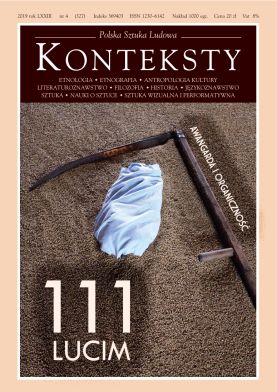Dotykanie wzrokiem. O pojęciu haptyczności w klasycznej nauce o sztuce
Touching with Sight. On the Concept of Haptic Perception in Classical Art Studies
Author(s): Wojciech BałusSubject(s): Fine Arts / Performing Arts
Published by: Instytut Sztuki Polskiej Akademii Nauk
Keywords: haptic perception;art;
Summary/Abstract: The concept of haptic perception appeared in art studies in about 1900 when the history of art embarked upon the construction of its specificity by creating the theoretical foundations of applied methodology. Concentrated on formal questions, it perceived the essence of research in stylistic ascertainment. By seeking adequate instruments for capturing the phenomenon of the visible form of an artwork in linguistic categories researchers of the period turned their attention to Adolf von Hildebrand’s Das Problem der Form in der bildenden Kunst (Problem of Form in Painting and Sculpture), from which they borrowed the distinction between seeing (Sehen) and scanning / looking at (Schauen). Schauen was associated with the movement of the eyeballs and resembled the function fulfilled by the sense of touch: when the onlooker followed the contour of an object he performed something analogous to running a finger over the edge of that object, and when he gazed at a surface he acted in the fashion of someone who touches an object with his whole hand. This distinction was applied in conceptions introduced by Alois Riegl, Heinrich Wölfflin, and Bernard Berenson, who preferred the sense of sight as the source of the perception of artistic phenomena. In their theories touch fulfilled an auxiliary function and, according to their opinions, it corresponded, on the one hand, to the early stages in the development of man, when the process of becoming acquainted with reality calls for motion and physical contact with the objects surrounding us; on the other hand, touch was indispensable for a metaphorical definition of a certain type of perception or devising a visual arts form. Using sight alone, not only without resorting to hands but also in a dual manner – first in an optic modus and then in a haptic one – was, therefore, an expression of civilizational maturity. Contemporary studies from the domains of psychology and neurophysiology indicate that the elimination of haptic experiences from the processes of creating and receiving an image is impossible upon every stage in the life of an individual and entire societies. This means that Hildebrand, Riegl, Wölfflin and Berenson as well as the psychologists and philosophers up whom they based themselves intentionally rejected the appreciation of touch and a priori assumed the dominating role of the sense of sight, although they must have been aware of the role played in life by kinesthesis and haptic impressions. The conception of art and corporeality, obligatory at the end of the nineteenth century, was responsible for the preference for sight and assumed a total disjunction of life and art. According to it, painting or sculpture had to use material which only due to processing and covering it with paint began to present a figure or a view. In art similarity was to be the outcome exclusively of the artist’s skill, capable of creating an illusion of naturalness with the assistance of paint or a chisel. The essence of thus comprehended art was Walter Benjamin’s “aura”. When did this conception cease to be obligatory? The symbolic onset of its erosion could be the year 1936, when The Work of Art in the Age of Mechanical Reproduction was written. This essay by Benjamin was by no means an apology of aura. On the contrary, it voiced a positive opinion about its fall in a world undergoing modernisation and attempted to indicate the symptoms and causes of this state of things. A significant symptom of the new epoch was the emancipation of haptic values. The division into art, life, and body became questioned. A true rapprochement of art and life did not take place until after World War II. First, it entailed the strategy of “disassembling” the traditional image by piercing it, undertaken by assorted artists, and, subsequently, by directly using the actual body of the artist as a medium that could be, i.a. touched.
Journal: Konteksty
- Issue Year: 327/2019
- Issue No: 4
- Page Range: 202-207
- Page Count: 6
- Language: Polish
- Content File-PDF

